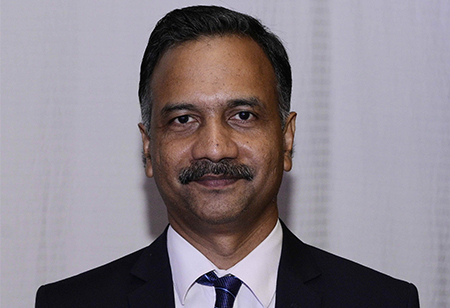Industry-Driven Learning: The Impact of Collaboration on Engineering Curricula
 Sameer boasts over 25 years of professional expertise, having authored 30 journal papers, notably in esteemed IEEE Transactions, along with 47 conference papers. He holds two patents in the US and one in India, and has been honored with multiple Best Paper awards at prestigious conferences. In a conversation with Higher Education Review Magazine, Sameer shared his views and thoughts on how interdisciplinary studies can be integrated into the engineering curriculum to produce more well-rounded graduates, as well as in what ways industry collaboration could enhance the engineering curriculum.
Sameer boasts over 25 years of professional expertise, having authored 30 journal papers, notably in esteemed IEEE Transactions, along with 47 conference papers. He holds two patents in the US and one in India, and has been honored with multiple Best Paper awards at prestigious conferences. In a conversation with Higher Education Review Magazine, Sameer shared his views and thoughts on how interdisciplinary studies can be integrated into the engineering curriculum to produce more well-rounded graduates, as well as in what ways industry collaboration could enhance the engineering curriculum.
What key changes would you propose to make engineering education more relevant to the current industry scenario?
Engineering education is at cross-roads now with the curricula of many specializations offered even in premier institutions in the country are struggling to meet the expectations of the Industry. With industry 4.0 related technological developments and opportunities related to AI and machine learning proliferating into many diverse areas in engineering, the curriculum needs to undergo some radical transformations to include such topics at an early stage of engineering education like 2nd or 3rd semester on a compulsory basis so that students will be able to credit advanced topics in these areas as electives and projects. The conventional approach followed for many decades in the engineering curriculum design such as having a common first year where every student admitted to a university or Institute is forced to learn certain subjects without really understanding their motivation needs to be replaced with program specific curricula from the first year itself. This will help the students to get a feel of their chosen specialization right from the first year. Internships in industries can be introduced as early as second year itself, so that students will be able to comeback with greater focus after the internship in terms of choosing electives and projects. Also, efforts are to be taken to introduce one semester internship in industries in the third year or the final year. It would be great if at-least 2 electives of every program are delivered by industry experts either fully or partially. Institutions also should strive hard to bring industry challenges to the attention of students and promote them to tackle them as part of their project works.
How can interdisciplinary studies be integrated into the engineering curriculum to produce more well-rounded graduates?
We all generally agree that most of the engineering problems require solutions involving multiple specializations. But the curricula of almost all engineering programs are designed with hard boundaries. Many of the faculty members are obsessed with the subjects they teach and think that the engineering studies in a particular specialization will be incomplete without their subjects. While it will take time to change this thought process, a relatively easier option that Institutions and universities can do is to offer truly interdisciplinary/multidisciplinary Minor programs along with the Major. Such Minors can be offered in cutting edge emerging areas relevant to the industry and they can be offered by two or three departments together. These minor programs needs to be periodically reviewed and help from industry can be sought for delivering some of the courses in the minor programs.
How should soft skills such as communication and teamwork be integrated into engineering education?
This is a very important aspect in any education in the modern times and engineering in particular. Again, this can be achieved through curricular interventions as well as extra and co-curricular activities. The pedagogical methods should include group tasks, presentations, micro-projects, case-study discussions and all students should be encouraged to participate in such activities. Adequate credits can be earmarked for the extra and co-curricular activities such as organizing programs, presenting papers, sports and games, professional society activities etc. Opportunities may be given for learning new languages and promote cross-cultural interactions.
In what ways do you think industry collaboration could enhance the engineering curriculum?
It is a challenging task to incorporate the topics of interests of a large number of industries in the curriculum as they may be so diverse in depth and breadth. However, we can make some efforts to constitute industry advisory boards for every departments with people with adequate and diverse expertise. Their opinion and vetting can be made as mandatory for every curriculum revision. While it may be difficult to play with core subjects of a specialization, elective courses and minor programs can be designed and delivered with industry support. The recently introduced initiative of Govt. of India for appointing “Professor of Practice” is a good opportunity to bring domain experts from industry for short tenures in academia. Faculty members can be provided with incentives to take-up industrial consultancies. Industrial internships should also evolve to the next level where the faculty members and industrial experts collaborate along with students who do internships.
How can feedback mechanisms be implemented to continuously improve the engineering curriculum?
Feedback mechanisms exit in almost all engineering institutions for meeting the regulatory compliance requirements and accreditations. However, feedback analysis and action taken on the outcome of such analysis are important and we need to retrospect whether that happens fruitfully. Annual review of feedbacks from all stake holders and corrective actions are important in keeping the program curriculum relevant and attractive. Though internal quality assurance wings are there in many institutions, I think we need to make significant improvements in this domain.

